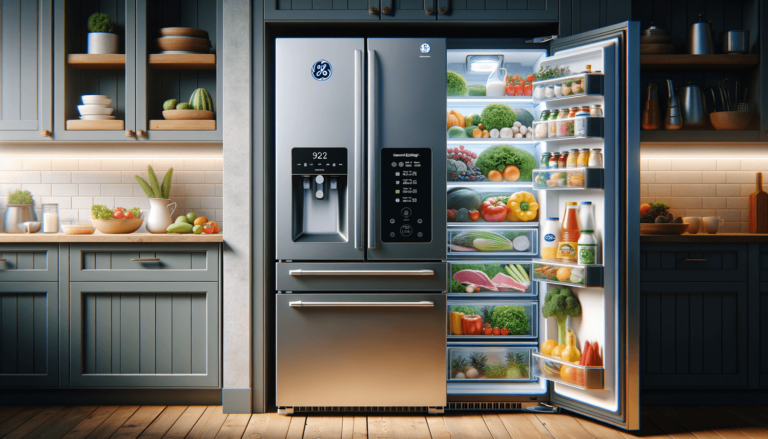

Are you confused by your refrigerator’s complex control panel and various functions? Worry no more, because in this blog post, we will delve into the intricacies of GE Refrigerator Settings Explained. We aim to help you gain a comprehensive understanding of your appliance’s capabilities and enable you to make the most out of your GE refrigerator. No longer will you have to wonder if you’re optimally utilizing your fridge, as we’ll guide you through temperature settings, cooling modes, and other features
Temperature settings in a GE refrigerator can be easily adjusted using the control panel. The ideal temperature range for a refrigerator is between 34°F and 38°F, while the freezer should be set to 0°F.
GE refrigerators offer various cooling modes, designed to meet specific needs and preferences:
Some GE refrigerator models are equipped with a defrost setting to help control frost accumulation. They include:
GE refrigerators may include alarm settings to alert you when the doors are left open, temperature fluctuations occur, or the water filter needs replacement. Common alarm settings include:
GE refrigerators may feature a Control Lock setting, which prevents accidental changes to the settings or unauthorized access:
Settings King, a blog about technology settings, is here to help you become an expert in managing your refrigerator settings to achieve the perfect balance of energy efficiency and food preservation.
Understanding how to arrange different food items according to the varying temperature zones in your refrigerator will significantly increase their shelf life:
Besides using the Energy Saver mode, a few simple practices ensure lower energy consumption while maintaining optimal cooling performance:
If you notice odd behaviors of your GE refrigerator, certain simple checks may identify the issue:
At Settings King, a blog about technology settings, we understand how crucial it is to not only comprehend the functions offered by your GE refrigerator but also put them to best use every day. By mastering your refrigerator settings, you can create a seamless experience, ensuring you are efficiently preserving your food while contributing to cost savings and a greener environment.
Once you’ve grasped the basic GE refrigerator settings, it’s all about organizing different food items in a way that makes the most of the various temperature zones. The key is to create designated sections for certain categories of foods, making it easier for you and your family to maintain the organization and prolong the freshness of your groceries.
Proper maintenance of your GE refrigerator is vital for efficient operations. This involves not only regular cleaning but also being mindful of your surroundings – keeping the area around the refrigerator clean, checking for proper spacing, and not obstructing airflow. Additionally, following a routine maintenance schedule as suggested by the manufacturer helps to keep your refrigerator running smoothly and economically for years to come.
Empower yourself with the knowledge you need to make the most of your GE refrigerator! At Settings King, we strive to provide insightful, step-by-step guides that simplify your journey through the world of technology settings. So, if you need assistance with appliances or tech gadgets, Settings King has got your back, making sure you get the most out of your devices with ease and confidence.
Our readers often have a range of questions related to GE refrigerator settings and maintenance. We’ve curated the most common queries along with their answers to help you find the information you need, quickly and efficiently.
First, check the temperature settings to ensure they are within the recommended ranges (34°F to 38°F for the fridge and 0°F for the freezer). Ensure that no items are blocking the air vents, and that the door seals are clean and providing a proper seal. If cooling issues persist, it may be time to call a professional for assistance.
Replacing the water filter every 6 months is generally recommended for optimal performance. However, the frequency may vary based on usage and water quality. Remember to check for any indicator lights or alarms and refer to the user manual for model-specific recommendations.
Turn off the appliance or unplug it from the power source. Remove all food items and store them in coolers with ice packs. Place towels around the base of the fridge to catch water runoff. Allow the frost to melt at room temperature or you can speed up the process using a hairdryer. Once fully defrosted, wipe down the interior, plug the appliance back in, and restore the optimal temperature settings before returning the food items.
Loud fridge noises can be due to improper leveling, blocked air vents, or dirty condenser coils. Check if the refrigerator is level and resting evenly on all feet. Ensure no items are obstructing air vents. Clean the condenser coils and maintain the area around the refrigerator free from debris. If the noises persist, contact a professional for further inspection.
GE refrigerators are designed to operate in temperature-controlled environments. Storing your refrigerator in locations with extreme hot or cold temperatures can adversely affect its performance and cause undue stress on the appliance. It is recommended to place your refrigerator in an indoor location with consistent temperatures.